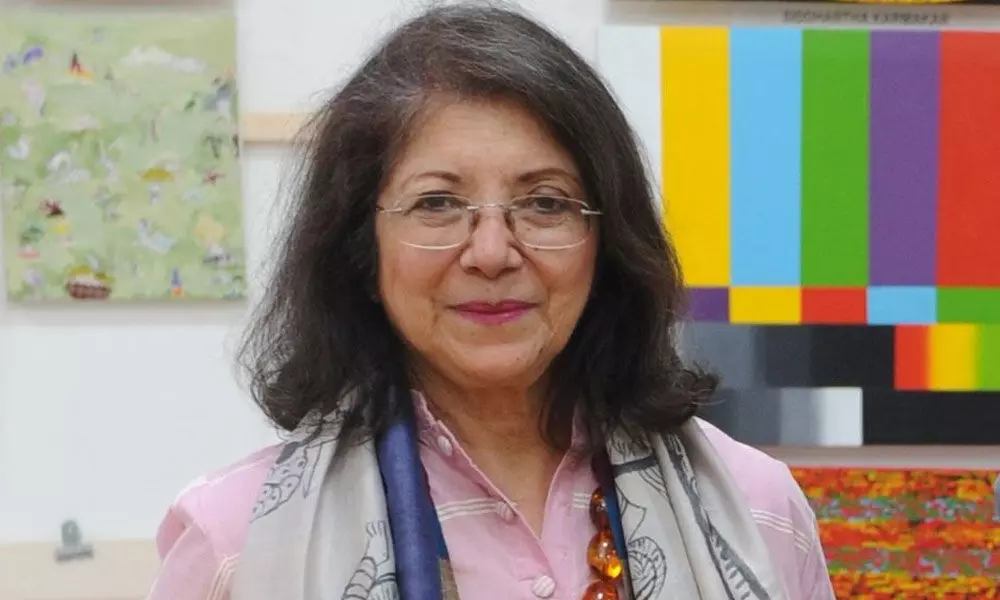Live
- 13 criminals from two gangs arrested in Jharkhand's Ramgarh for extortion
- Union Minister Bandi Sanjay Visits Injured Boy Sritej at KIMS Hospital
- Construction of over 1,000 bridges underway in Assam: CM Sarma
- Telangana IAS Officers wives association meets president Droupadi Murmu
- Nara Devaansh Sets World Record with Checkmate Marathon
- India set to become developed nation by 2047: Haryana CM
- Allu Arjun’s house attacked by protesters demanding compensation for the stampede victim
- Several Gulf countries impose visa ban on Pakistanis over their involvement in crime, fraud and begging
- Public outrage in Jharkhand's Giridih over murder, police station gheraoed
- Santosh Trophy: Meghalaya edge Goa 1-0 to secure QF berth
Just In
Art can't be just for the elite and wealthy: Rakhi Sarkar


Art can't be just for the elite and wealthy: Rakhi Sarkar
Our aim has been to provide an all India platform for young artists, especially to those coming from smaller towns and semi-rural areas of the country.
"Our aim has been to provide an all India platform for young artists, especially to those coming from smaller towns and semi-rural areas of the country. We are happy with the way the project has impacted the lives and career graphs of young artists. Galleries, universities and institutions have imbibed much of the talents that have emerged from CIMA Awards," says Rakhi Sarkar is the founder of CIMA (Centre of International Modern Art), one of India's premier art centres.
The recently concluded fourth edition of CIMA awards for visual arts witnessed 183 artworks from across the country shortlisted for the final round by the preliminary jury and 13 winners and their works selected by the final one (jury).
Widely known for setting up the 'Affordable Art Mela' that aims to bring art back into the public domain by offering an opportunity to buy art at affordable prices, Sarkar who brought the 'mela' to Delhi (2018) and Mumbai (2020) after a positive reception in Kolkata for over a decade, says, "To appreciate beauty, excellence and talent remains every individual's right. If you accept this, then art cannot remain the purview of the wealthy and elite alone. We hope to extend it to non-metropolitan towns as well," she adds.
Interesting several major artists offer their works for the mela at much lower costs. "They are supportive in order to provide young professionals and intellectuals with an opportunity to collect serious art at affordable prices. The 'mela' aspires to promote young collectors," says Sarkar.
This Founder Managing Trustee of the Kolkata Museum of Modern Art (KMOMA) for a decade laments that curation is yet to get its place in the Indian art scene and says it is not practised seriously here. "There is no scope whatsoever for getting training from art institutions and museums. Curation has a practical angle. One learns first-hand through ground experience. It involves imagination and creative flair. The investigative side involves research and erudition, but the final narrative and presentation need creativity and flair. We need seamless integration of the two elements."
Talking about how most galleries have adopted a hybrid model in the face of the Pandemic, she feels that digital is an alternative and certainly better than not showing at all, and to an extent bridging gaps between destinations. "However, this virtual mode cannot be a replacement for physical exhibitions without which the scale and actual visual impact is lost completely," she says.
Adding that what most artists have gone through in the past two years necessitate a kind of an umbrella organisation boasting of public and private partnership that extends help in such dire times, she elaborates, "The recent past has witnessed so many artists from across the spectrum going through immense financial insecurity. An
he organisation on such lines can ensure some kind of support during a huge crisis like the one we witnessed in the form of Pandemic."
A decade back, in her capacity as the Chairperson of FICCI Art Council for Ministry of Culture, GOI, Sarkar had recommended through a detailed policy framework document a total overhaul of the syllabus of art schools, in partnership with major visual art faculties from across the world, but sadly nothing has been implemented as yet.
"The of art schools' curriculum is dismally outdated, and the 19th-century model is still in use. The conceptual side of art-making is totally overlooked and the theoretical framework is very sketchy and inadequate. Until the standard of education improves the quality and depth of art practice will remain severely hampered," says Sarkar.
Talking about the multiple private art foundations that have come up in the country, especially Kolkata, she says, "It is excellent that several art institutions are coming up in the private sector. There is room for more across the country, given how vast and varied India is. These art institutions are fulfilling a paramount role in promoting and nurturing art."

© 2024 Hyderabad Media House Limited/The Hans India. All rights reserved. Powered by hocalwire.com






